
PDSA ou PDCA?
Os mitos sobre o ciclo de Deming e sua evolução.
Um interessante texto sobre o PDSA e PDCA foi escrito por Ronald Moen e você pode conferir no link https://www.deming.org/sites/default/files/pdf/2015/PDSA_History_Ron_Moen.pdf
Leia um trecho do link:
Abstract
This paper provides a history of W. Edwards Deming’s PDSA Cycle for Learning and Improvement. It starts with a philosophy of science and Galileo in the 1600’s and moves through Deming’s last version of the PDSA Cycle of 1993. It includes the Shewhart Cycle of 1939, the Deming Wheel (circle) of 1950, The Japanese PDCA of 1951 and 1985, and the evolution of the Deming’s PDSA from 1986 through 1993. It concludes with some of Deming’s reactions to the PDCA.
1. Introduction
Much confusion continues today about W. Edwards Deming’s PDSA Cycle. I had a unique opportunity to communicate with Dr. Deming over the 1981-1993 time frames. I managed his monthly visits to Pontiac Motor Division of General Motors from 1982 through 1986 and was a Deming helper at 70 of his famous 4-day seminars from 1982 through 1993. He also reviewed several papers and a book that I co-authored in that time period.
The confusion can be summarized in these three basic questions:
1. How did Deming’s PDSA evolve?
2. Did Deming create the PDCA?
3. Are the PDCA and PDSA related?
2. Scientific Method: Foundation for the PDSA Cycle
Figure 1 provides a brief sketch of the history of the scientific method beginning with Galileo in 1610 through pragmatism of the early 1900’s and the evolution of the PDCA Cycle and the PDSA Cycle through 1993.
Galileo Galilei
Galileo Galilei (1564-1642) is considered by many to be the father of modern science. Galileo made original contributions to the science of motion and strengths of materials by combining designed experiments and mathematics. Conducting designed experiments are a cornerstone of science and the scientific method.
Francis Bacon (1561-1626) made his contribution as a philosopher who was very concerned about the manner in which knowledge is developed. Bacon believes that the generation of knowledge needs to follow a planned structure. Science at the time depended on deductive logic to interpret nature. Bacon insisted that the scientist should instead proceed through inductive reasoning, from observations to axiom to law. Bacon’s contribution completed the interplay between deductive and inductive logic that underlies how we advance knowledge.
Charles Peirce and William James [1] met in Cambridge outside of Harvard in January of 1872 to form a discussion group called the “Metaphysical Club.” This group of people would forever be linked with the uniquely American philosophy that we call “pragmatism.” They stated that the function of thought is to guide action, and that truth is preeminently to be tested by the practical consequences of belief.
John Dewey (1859-1952) [2] became a leading proponent of pragmatism and his works would influence philosophy, education, religion, government, and democracy around the world. The pragmatism of James and Dewey could be summarized in the statement: people are the agents of their own destinies.
Clarence Irving Lewis (1883-1964) [3] an American pragmatist educated at Harvard was heavily influenced by both William James and Charles Pierce. Lewis set out three main ideas in Mind and the World Order to further the pragmatist’s influence:
1. a priori truth is definitive and offers criteria by means of which experience can be discriminated;